The Contribution of Scalded and Scalded-Fermented Rye Wholemeal Flour to Quality Parameters and Acrylamide Formation in Semi-Wheat-Rye Bread
Abstract
:1. Introduction
2. Materials and Methods
2.1. Materials Used for Bread Preparation
2.2. Scald Preparation and Fermentation
2.3. Breadmaking
2.4. Evaluation of Non-Treated, Scalded (Sc) and Scalded-Fermented (FSc) Rye Wholemeal Flour Parameters
2.5. Evaluation of Bread Quality
2.6. Determination of Acrylamide in Bread
2.7. Statistical Analysis
3. Results and Discussion
3.1. Parameters of Scalded (Sc) and Scalded-Fermented (FSc) Rye Wholemeal Flour
3.2. Bread Quality
3.3. Sensory Properties and Overall Acceptability of Bread Samples
3.4. Acrylamide Concentration in Bread
4. Conclusions
Author Contributions
Funding
Data Availability Statement
Acknowledgments
Conflicts of Interest
References
- Xu, X.; Luo, Z.; Yang, Q.; Xiao, Z.; Lu, X. Effect of Quinoa Flour on Baking Performance, Antioxidant Properties and Digestibility of Wheat Bread. Food Chem. 2019, 294, 87–95. [Google Scholar] [CrossRef] [PubMed]
- Tsykhanovska, I.; Evlash, V.; Alexandrov, A.; Svidlo, K.; Gontar, T. Research quality of the wheat–rye bread with addition of the polyfunctional food supplement «Magnetofood». EUREKA Life Sci. 2017, 5, 45–52. [Google Scholar] [CrossRef]
- Graça, C.; Fradinho, P.; Sousa, I.; Raymundo, A. Impact of Chlorella Vulgaris on the Rheology of Wheat Flour Dough and Bread Texture. LWT 2018, 89, 466–474. [Google Scholar] [CrossRef]
- Ooms, N.; Delcour, J.A. How to Impact Gluten Protein Network Formation during Wheat Flour Dough Making. Curr. Opin. Food Sci. 2019, 25, 88–97. [Google Scholar] [CrossRef]
- Fernández-Peláez, J.; Paesani, C.; Gómez, M. Sourdough Technology as a Tool for the Development of Healthier Grain-Based Products: An Update. Agronomy 2020, 10, 1962. [Google Scholar] [CrossRef]
- Müller, D.C.; Nguyen, H.; Li, Q.; Schönlechner, R.; Miescher Schwenninger, S.; Wismer, W.; Gänzle, M. Enzymatic and Microbial Conversions to Achieve Sugar Reduction in Bread. Food Res. Int. Ott. Ont. 2021, 143, 110296. [Google Scholar] [CrossRef]
- Mollakhalili-Meybodi, N.; Sheidaei, Z.; Khorshidian, N.; Nematollahi, A.; Khanniri, E. Sensory attributes of wheat bread: A review of influential factors. J. Food Meas. Charact. 2022, 1–10. [Google Scholar] [CrossRef]
- Malik, V.S.; Li, Y.; Pan, A.; De Koning, L.; Schernhammer, E.; Willett, W.C.; Hu, F.B. Long-Term Consumption of Sugar-Sweetened and Artificially Sweetened Beverages and Risk of Mortality in US Adults. Circulation 2019, 139, 2113–2125. [Google Scholar] [CrossRef]
- Te Morenga, L.; Mallard, S.; Mann, J. Dietary Sugars and Body Weight: Systematic Review and Meta-Analyses of Randomised Controlled Trials and Cohort Studies. BMJ 2013, 346, e7492. [Google Scholar] [CrossRef] [Green Version]
- Imamura, F.; O’Connor, L.; Ye, Z.; Mursu, J.; Hayashino, Y.; Bhupathiraju, S.N.; Forouhi, N.G. Consumption of Sugar Sweetened Beverages, Artificially Sweetened Beverages, and Fruit Juice and Incidence of Type 2 Diabetes: Systematic Review, Meta-Analysis, and Estimation of Population Attributable Fraction. BMJ 2015, 351, h3576. [Google Scholar] [CrossRef] [Green Version]
- Park, M.H.; Falconer, C.; Viner, R.M.; Kinra, S. The Impact of Childhood Obesity on Morbidity and Mortality in Adulthood: A Systematic Review. Obes. Rev. 2012, 13, 985–1000. [Google Scholar] [CrossRef] [PubMed]
- Ooi, J.Y.; Wolfenden, L.; Sutherland, R.; Nathan, N.; Oldmeadow, C.; Mclaughlin, M.; Barnes, C.; Hall, A.; Vanderlee, L.; Yoong, S.L. A Systematic Review of the Recent Consumption Levels of Sugar-Sweetened Beverages in Children and Adolescents From the World Health Organization Regions With High Dietary–Related Burden of Disease. Asia Pac. J. Public Health 2022, 34, 11–24. [Google Scholar] [CrossRef]
- World Healt Organization. Guideline: Sugars Intake for Adults and Children; WHO: Geneva, Switzerland, 2015; ISBN 92-4-154902-5. [Google Scholar]
- Foster-Powell, K.; Holt, S.H.; Brand-Miller, J.C. International Table of Glycemic Index and Glycemic Load Values: 2002. Am. J. Clin. Nutr. 2002, 76, 5–56. [Google Scholar] [CrossRef] [PubMed] [Green Version]
- European Food Safety Authority Update on Acrylamide Levels in Food from Monitoring Years 2007 to 2010. EFSA J. 2012, 10, 2938. [CrossRef]
- Przygodzka, M.; Piskula, M.K.; Kukurová, K.; Ciesarová, Z.; Bednarikova, A.; Zieliński, H. Factors Influencing Acrylamide Formation in Rye, Wheat and Spelt Breads. J. Cereal Sci. 2015, 65, 96–102. [Google Scholar] [CrossRef]
- Bartkiene, E.; Jakobsone, I.; Juodeikiene, G.; Vidmantiene, D.; Pugajeva, I.; Bartkevics, V. Effect of Fermented Helianthus Tuberosus L. Tubers on Acrylamide Formation and Quality Properties of Wheat Bread. LWT-Food Sci. Technol. 2013, 54, 414–420. [Google Scholar] [CrossRef]
- Bartkiene, E.; Jakobsone, I.; Juodeikiene, G.; Vidmantiene, D.; Pugajeva, I.; Bartkevics, V. Effect of Lactic Acid Fermentation of Lupine Wholemeal on Acrylamide Content and Quality Characteristics of Wheat-Lupine Bread. Int. J. Food Sci. Nutr. 2013, 64, 890–896. [Google Scholar] [CrossRef]
- Bartkiene, E.; Jakobsone, I.; Juodeikiene, G.; Vidmantiene, D.; Pugajeva, I.; Bartkevics, V. Study on the Reduction of Acrylamide in Mixed Rye Bread by Fermentation with Bacteriocin-like Inhibitory Substances Producing Lactic Acid Bacteria in Combination with Aspergillus Niger Glucoamylase. Food Control 2013, 30, 35–40. [Google Scholar] [CrossRef]
- Bartkiene, E.; Jakobsone, I.; Pugajeva, I.; Bartkevics, V.; Vidmantiene, D.; Juodeikiene, G. Influence of the Addition of Helianthus Tuberosus L. Fermented with Different Lactobacilli on Acrylamide Content in Biscuits. Int. J. Food Sci. Technol. 2015, 50, 431–439. [Google Scholar] [CrossRef]
- Bartkiene, E.; Jakobsone, I.; Pugajeva, I.; Bartkevics, V.; Zadeike, D.; Juodeikiene, G. Reducing of Acrylamide Formation in Wheat Biscuits Supplemented with Flaxseed and Lupine. LWT-Food Sci. Technol. 2016, 65, 275–282. [Google Scholar] [CrossRef]
- Bartkiene, E.; Bartkevics, V.; Pugajeva, I.; Krungleviciute, V.; Mayrhofer, S.; Domig, K. The Contribution of P. Acidilactici, L. Plantarum, and L. Curvatus Starters and L-(+)-Lactic Acid to the Acrylamide Content and Quality Parameters of Mixed Rye-Wheat Bread. LWT 2017, 80, 43–50. [Google Scholar] [CrossRef]
- Bartkiene, E.; Bartkevics, V.; Pugajeva, I.; Krungleviciute, V.; Mayrhofer, S.; Domig, K. Parameters of Rye, Wheat, Barley, and Oat Sourdoughs Fermented with Lactobacillus Plantarum LUHS135 That Influence the Quality of Mixed Rye–Wheat Bread, Including Acrylamide Formation. Int. J. Food Sci. Technol. 2017, 52, 1473–1482. [Google Scholar] [CrossRef]
- Bartkiene, E.; Bartkevics, V.; Krungleviciute, V.; Pugajeva, I.; Zadeike, D.; Juodeikiene, G. Lactic Acid Bacteria Combinations for Wheat Sourdough Preparation and Their Influence on Wheat Bread Quality and Acrylamide Formation. J. Food Sci. 2017, 82, 2371–2378. [Google Scholar] [CrossRef] [PubMed]
- Bartkiene, E.; Bartkevics, V.; Krungleviciute, V.; Pugajeva, I.; Zadeike, D.; Juodeikiene, G.; Cizeikiene, D. The Influence of Scalded Flour, Fermentation, and Plants Belonging to Lamiaceae Family on the Wheat Bread Quality and Acrylamide Content. J. Food Sci. 2018, 83, 1560–1568. [Google Scholar] [CrossRef]
- Bartkiene, E.; Bartkevics, V.; Lele, V.; Pugajeva, I.; Zavistanaviciute, P.; Zadeike, D.; Juodeikiene, G. Application of Antifungal Lactobacilli in Combination with Coatings Based on Apple Processing By-Products as a Bio-Preservative in Wheat Bread Production. J. Food Sci. Technol. 2019, 56, 2989–3000. [Google Scholar] [CrossRef] [PubMed]
- Bartkiene, E.; Lele, V.; Ruzauskas, M.; Domig, K.J.; Starkute, V.; Zavistanaviciute, P.; Bartkevics, V.; Pugajeva, I.; Klupsaite, D.; Juodeikiene, G.; et al. Lactic Acid Bacteria Isolation from Spontaneous Sourdough and Their Characterization Including Antimicrobial and Antifungal Properties Evaluation. Microorganisms 2020, 8, 64. [Google Scholar] [CrossRef] [Green Version]
- McGuire, R.G. Reporting of Objective Color Measurements. HortScience 1992, 27, 1254–1255. [Google Scholar] [CrossRef] [Green Version]
- AACC Approved Methods of Analysis, 11th Edition—AACC Method 10-05.01. Guidelines for Measurement of Volume by Rapeseed Displacement. Available online: http://methods.aaccnet.org/summaries/10-05-01.aspx (accessed on 17 October 2022).
- ISO-8586 Sensory Analysis—General Guidelines for the Selection, Training and Monitoring of Selected Assessors and Expert Sensory Assessors. Available online: https://www.iso.org/cms/render/live/en/sites/isoorg/contents/data/standard/04/53/45352.html (accessed on 15 October 2022).
- Zhang, Y.; Dong, Y.; Ren, Y.; Zhang, Y. Rapid Determination of Acrylamide Contaminant in Conventional Fried Foods by Gas Chromatography with Electron Capture Detector. J. Chromatogr. A. 2006, 1116, 209–216. [Google Scholar] [CrossRef] [PubMed]
- Mūrniece, R.; Kļava, D. Impact of Long-Fermented Sourdough on the Technological and Prebiotical Properties of Rye Bread. Proc. Latv. Acad. Sci. Sect. B Nat. Exact Appl. Sci. 2022, 76, 1–8. [Google Scholar] [CrossRef]
- Nie, Q.; Feng, L.; Hu, J.; Wang, S.; Chen, H.; Huang, X.; Nie, S.; Xiong, T.; Xie, M. Effect of Fermentation and Sterilization on Anthocyanins in Blueberry. J. Sci. Food Agric. 2017, 97, 1459–1466. [Google Scholar] [CrossRef]
- Olamiti, G.; Takalani, T.K.; Beswa, D.; Jideani, A.I.O. Effect of Malting and Fermentation on Colour, Thermal Properties, Functional Groups and Crystallinity Level of Flours from Pearl Millet (Pennisetum Glaucum) and Sorghum (Sorghum Bicolor). Heliyon 2020, 6, e05467. [Google Scholar] [CrossRef] [PubMed]
- Zykin, P.A.; Andreeva, E.A.; Tsvetkova, N.V.; Voylokov, A.V. Anatomical and Image Analysis of Grain Coloration in Rye. Preprints 2020, 11, 530. [Google Scholar]
- Hadaegh, H.; Seyyedain Ardabili, S.M.; Tajabadi Ebrahimi, M.; Chamani, M.; Azizi Nezhad, R. The Impact of Different Lactic Acid Bacteria Sourdoughs on the Quality Characteristics of Toast Bread. J. Food Qual. 2017, 2017, e7825203. [Google Scholar] [CrossRef] [Green Version]
- Fu, L.; Nowak, A.; Zhao, H.; Zhang, B. Relationship between Microbial Composition of Sourdough and Texture, Volatile Compounds of Chinese Steamed Bread. Foods 2022, 11, 1908. [Google Scholar] [CrossRef] [PubMed]
- Li, H.; Dai, F.; Zhang, L.; Li, Z. Characterization of Scalded Dough and Its Impact on the Growth of Mixed Yeasts Originating from Jiaozi. Food Biosci. 2022, 49, 101920. [Google Scholar] [CrossRef]
- Petrova, P.; Petrov, K. Lactic Acid Fermentation of Cereals and Pseudocereals: Ancient Nutritional Biotechnologies with Modern Applications. Nutrients 2020, 12, 1118. [Google Scholar] [CrossRef] [PubMed] [Green Version]
- Gao, Q.; Liu, C.; Zheng, X. Effect of Heat Treatment of Rye Flour on Rye-Wheat Steamed Bread Quality. Int. J. Food Sci. Technol. 2018, 53, 1109–1119. [Google Scholar] [CrossRef]
- Alkay, Z.; Kilmanoğlu, H.; Durak, M.Z. Prevention of Sourdough Bread Mould Spoliage by Antifungal Lactic Acid Bacteria Fermentation. Avrupa. Bilim. Ve. Teknol. Derg. 2020, 18, 379–388. [Google Scholar] [CrossRef] [Green Version]
- Koistinen, V.M.; Mattila, O.; Katina, K.; Poutanen, K.; Aura, A.-M.; Hanhineva, K. Metabolic Profiling of Sourdough Fermented Wheat and Rye Bread. Sci. Rep. 2018, 8, 5684. [Google Scholar] [CrossRef] [Green Version]
- De Vuyst, L.; Van Kerrebroeck, S.; Harth, H.; Huys, G.; Daniel, H.-M.; Weckx, S. Microbial Ecology of Sourdough Fermentations: Diverse or Uniform? Food Microbiol. 2014, 37, 11–29. [Google Scholar] [CrossRef]
- Sahab, N.R.M.; Subroto, E.; Balia, R.L.; Utama, G.L. γ-Aminobutyric Acid Found in Fermented Foods and Beverages: Current Trends. Heliyon 2020, 6, e05526. [Google Scholar] [CrossRef]
- Melini, F.; Melini, V.; Luziatelli, F.; Ficca, A.G.; Ruzzi, M. Health-Promoting Components in Fermented Foods: An Up-to-Date Systematic Review. Nutrients 2019, 11, 1189. [Google Scholar] [CrossRef] [Green Version]
- Stromeck, A.; Hu, Y.; Chen, L.; Gänzle, M.G. Proteolysis and Bioconversion of Cereal Proteins to Glutamate and γ-Aminobutyrate (GABA) in Rye Malt Sourdoughs. J. Agric. Food Chem. 2011, 59, 1392–1399. [Google Scholar] [CrossRef] [PubMed]
- Marston, K.; Khouryieh, H.; Aramouni, F. Effect of Heat Treatment of Sorghum Flour on the Functional Properties of Gluten-Free Bread and Cake. LWT-Food Sci. Technol. 2016, 65, 637–644. [Google Scholar] [CrossRef]
- Fathi, B.; Aalami, M.; Kashaninejad, M.; Sadeghi Mahoonak, A. Utilization of Heat-Moisture Treated Proso Millet Flour in Production of Gluten-Free Pound Cake. J. Food Qual. 2016, 39, 611–619. [Google Scholar] [CrossRef]
- Hopek, M.; Ziobro, R.; Achremowicz, B. Comparison of the Effects of Microbial Alpha-Amylases and Scalded Flour on Bread Quality. Acta. Sci. Pol. Technol. Aliment. 2006, 1, 97–106. [Google Scholar]
- Djukic, D.; Radović, M.; Mandic, L.; Moracanin, S.V. Effect of Sourdough on the Fermentation of Dough Pieces and Quality of Bread Made with Rye Flour. Available online: https://keypublishing.org/jhed/wp-content/uploads/2020/07/01.-Dragutin-Djukic.pdf (accessed on 15 October 2022).
- Brandt, M.J. Sourdough Products for Convenient Use in Baking. Food Microbiol. 2007, 24, 161–164. [Google Scholar] [CrossRef]
- Kołodziejczyk, P.; Michniewicz, J.; Buchowski, M.S.; Paschke, H. Effects of Fibre-Rich Rye Milling Fraction on the Functional Properties and Nutritional Quality of Wholemeal Rye Bread. J. Food Sci. Technol. 2020, 57, 222–232. [Google Scholar] [CrossRef] [Green Version]
- Esteller, M.S.; Lannes, S.C.S. Production and Characterization of Sponge-Dough Bread Using Scalded Rye. J. Texture Stud. 2008, 39, 56–67. [Google Scholar] [CrossRef]
- Pejcz, E.; Spychaj, R.; Gil, Z. Technological Methods for Reducing the Content of Fructan in Rye Bread. Eur. Food Res. Technol. 2020, 246, 1839–1846. [Google Scholar] [CrossRef]
- Mihhalevski, A.; Heinmaa, I.; Traksmaa, R.; Pehk, T.; Mere, A.; Paalme, T. Structural Changes of Starch during Baking and Staling of Rye Bread. J. Agric. Food Chem. 2012, 60, 8492–8500. [Google Scholar] [CrossRef] [PubMed]
- Arendt, E.K.; Ryan, L.A.M.; Bello, F.D. Impact of Sourdough on the Texture of Bread. Food Microbiol. 2007, 24, 165. [Google Scholar] [CrossRef]
- Deleu, L.J.; Lemmens, E.; Redant, L.; Delcour, J.A. The Major Constituents of Rye (Secale cereale L.) Flour and Their Role in the Production of Rye Bread, a Food Product to Which a Multitude of Health Aspects Are Ascribed. Cereal Chem. 2020, 97, 739–754. [Google Scholar] [CrossRef]
- Ebrahimi, M.; Ali Noori, S.M.; Sadeghi, A.; Coban, O.E.; Zanganeh, J.; Ghodsmofidi, S.M.; Malvandi, Z.; Raeisi, M. Application of Cereal-Bran Sourdoughs to Enhance Technological Functionality of White Wheat Bread Supplemented with Pumpkin (Cucurbita Pepo) Puree. LWT 2022, 158, 113079. [Google Scholar] [CrossRef]
- Heenan, S.P.; Dufour, J.-P.; Hamid, N.; Harvey, W.; Delahunty, C.M. The Sensory Quality of Fresh Bread: Descriptive Attributes and Consumer Perceptions. Food Res. Int. 2008, 41, 989. [Google Scholar] [CrossRef]
- Onacik-Gür, S.; Szafrańska, A.; Roszko, M.; Stępniewska, S. Interaction of Dough Preparation Method, Green Tea Extract and Baking Temperature on the Quality of Rye Bread and Acrylamide Content. LWT 2022, 154, 112759. [Google Scholar] [CrossRef]
- Capuano, E.; Ferrigno, A.; Acampa, I.; Serpen, A.; Açar, Ö.Ç.; Gökmen, V.; Fogliano, V. Effect of Flour Type on Maillard Reaction and Acrylamide Formation during Toasting of Bread Crisp Model Systems and Mitigation Strategies. Food Res. Int. 2009, 42, 1295–1302. [Google Scholar] [CrossRef]
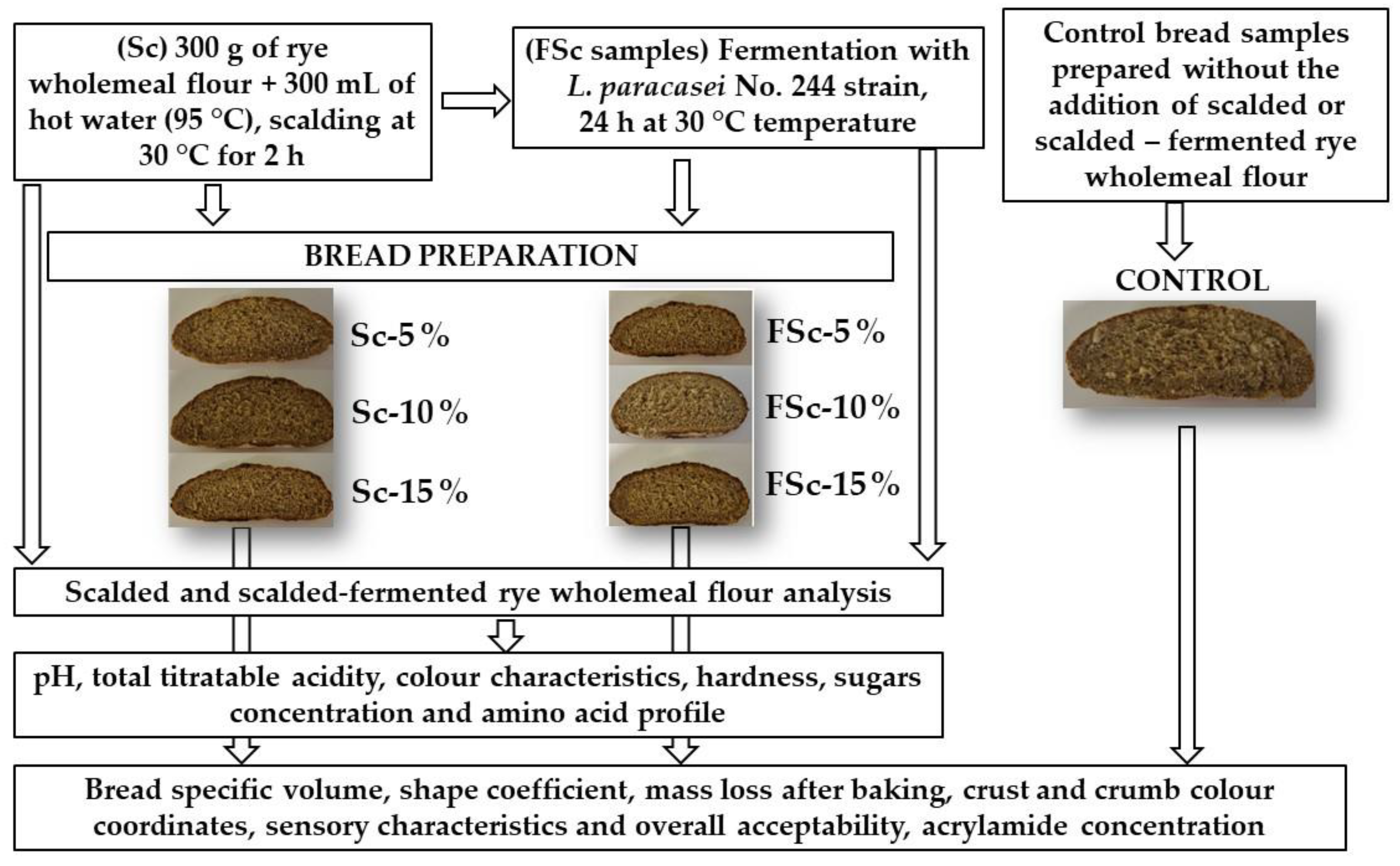
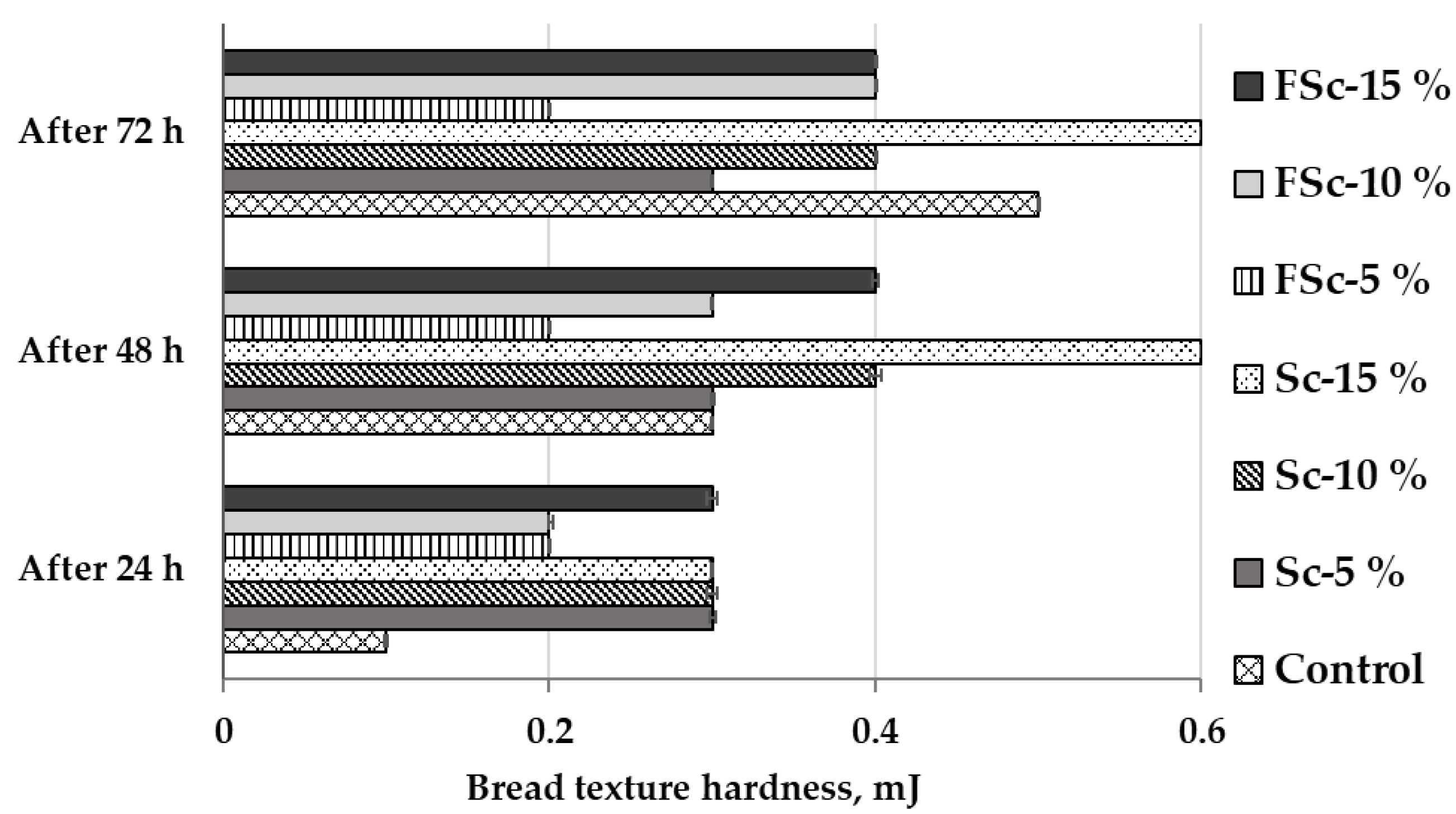


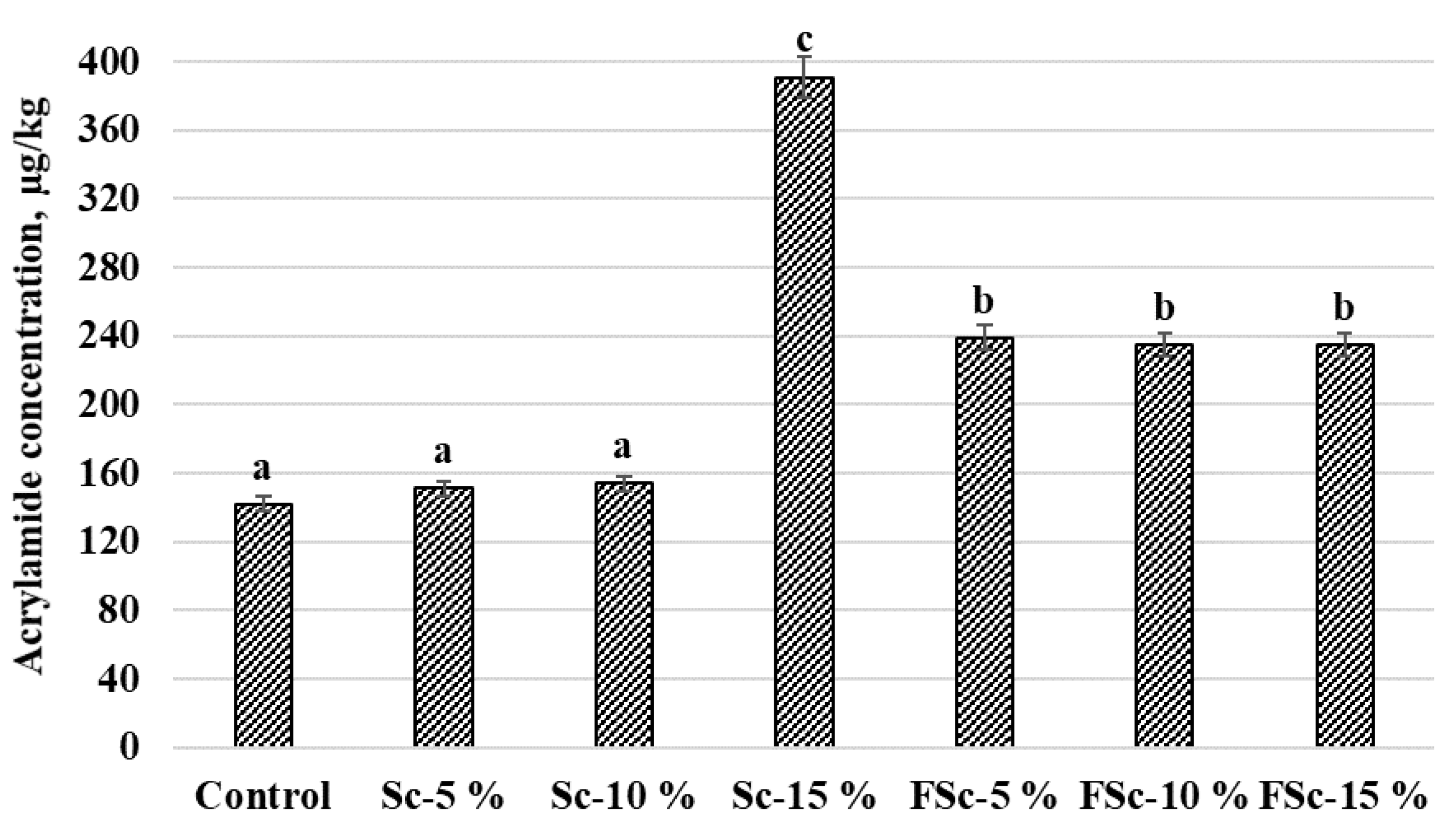
| 100 bp DNA-Ladder Extended | Lactiplantibacillus paracasei No. 244 | Gas Production, Tolerance to Temperature (10, 30, 37 and 45 °C), Low pH Conditions (pH 2.5 for 2 h) and Carbohydrate Metabolism of the Lactiplantibacillus paracasei No. 244 Strain | |||
|---|---|---|---|---|---|
 |  | Glycerol | - | Esculin | +++ |
| D-arabinose | - | Salicin | +++ | ||
| L-arabinose D-ribose D-xylose L-xylose D-adonitol Methyl-βD-xylopiranoside D-galactose D-glucose D-fructose D-mannose L-sorbose L-rhamnose Dulcitol Inositol D-mannitol D-sorbitol Methyl-αD-mannopyranoside Methyl-αD-glucopyranoside N-acetylglucosamine Amygdalin Arbutin | - +++ - +++ + - +++ +++ +++ +++ - +++ +++ - +++ +++ - +++ +++ +++ +++ | D-cellobiose D-maltose D-lactose D-melibiose D-saccharose D-trehalose Inulin D-melezitose D-raffinose Amidon Glycogen Xylitol Gentiobiose D-turanose D-tagatose D-fucose L-fucose D-arabitol L-arabitol Potassium gluconate Potassium 2-ketogluconate Potassium 5-ketogluconate | +++ +++ +++ - +++ +++ +++ +++ - - - - +++ +++ +++ - - - - ++ - - | ||
| Gas production (+/-) | - | ||||
| Temperature tolerance | 10 °C | - | |||
| 30 °C | ++ | ||||
| 37 °C | ++ | ||||
| 45 °C | - | ||||
| pH 2.5 | 0 h log (CFU/mL) | 9.41 ± 0.2 | |||
| 2 h log (CFU/mL) | 9.29 ± 0.1 | ||||
| Samples | Acidity Parameters | Colour Characteristics, NBS | Texture Hardness, mJ | |||
|---|---|---|---|---|---|---|
| pH | TTA, °N | L* | a* | b* | ||
| Sc | 6.22 ± 0.06 c | 1.04 ± 0.46 a | 35.13 ± 4.31 a | 2.46 ±0.25 a | 8.80 ± 1.27 a | 0.700 ± 0.100 b |
| FSc-0h | 5.95 ± 0.13 b | 1.23 ± 0.16 a | 34.37 ± 4.25 a | 2.56 ± 0.20 a | 10.8 ± 1.10 b | 0.770 ± 0.100 b |
| FSc-24h | 4.57 ± 0.05 a | 2.53 ± 0.15 b | 32.29 ± 0.08 a | 2.80 ± 0.21 b | 7.49 ± 0.01 a | 0.200 ± 0.050 a |
| Samples | Sugars, g/100 g | |||
|---|---|---|---|---|
| Monosaccharides | Disaccharides | |||
| Fructose | Glucose | Sucrose | Maltose | |
| Rye wholemeal flour | nd | nd | 1.61 ± 0.09 | 1.02 ± 0.09 a |
| Sc | 0.880 ± 0.034 a | 1.25 ± 0.08 a | nd | 6.26 ± 0.14 b |
| FSc-24h | 0.820 ± 0.053 a | 1.44 ± 0.03 b | nd | 6.95 ± 0.23 b |
| Compound Name | Rye Wholemeal Flour | Sc | FSc-24h |
|---|---|---|---|
| Free Amino Acids and GABA Concentration, µmol/g | |||
| Asparagine | 5.19 ± 0.26 b | 2.32 ± 0.17 a | 2.11 ± 0.16 a |
| Arginine | 1.94 ± 0.12 c | 0.855 ± 0.041 a | 1.08 ± 0.09 b |
| Serine | 0.785 ± 0.031 b | 0.368 ± 0.025 a | 0.354 ± 0.028 a |
| Aspartic acid | 2.33 ± 0.09 b | 0.528 ± 0.031 a | 0.517 ± 0.036 a |
| Glutamic acid | 0.896 ± 0.039 c | 0.281 ± 0.019 a | 0.321 ± 0.021 b |
| Threonine | 0.516 ± 0.028 c | 0.173 ± 0.011 a | 0.308 ± 0.018 b |
| Glycine | 0.453 ± 0.015 b | 0.259 ± 0.022 a | 0.429 ± 0.022 b |
| GABA | 0.456 ± 0.021 a | 0.482 ± 0.034 a | 0.689 ± 0.043 b |
| Alanine | 1.56 ± 0.11 c | 0.684 ± 0.041 a | 1.17 ± 0.08 b |
| Proline | 2.24 ± 0.15 b | 0.967 ± 0.053 a | 0.968 ± 0.039 a |
| Methionine | nd | nd | nd |
| Valine | nd | nd | nd |
| Phenylalanine | nd | nd | nd |
| Lysine | nd | nd | nd |
| Histidine | nd | nd | nd |
| Tyrosine | nd | nd | nd |
| Bread Samples | Specific Volume, cm3/g | Shape Coefficient | Mass Loss after Baking, % | ||||||||
|---|---|---|---|---|---|---|---|---|---|---|---|
| Control | 1.90 ± 0.11 a | 2.38 ± 0.19 b | 6.30 ± 0.83 a | ||||||||
| Sc-5% | 2.09 ± 0.09 a | 2.64 ± 0.22 b | 6.30 ± 0.83 a | ||||||||
| Sc-10% | 2.00 ± 0.12 a | 2.67 ± 0.19 b | 11.2 ± 0.86 b | ||||||||
| Sc-15% | 2.01 ± 0.08 a | 1.89 ± 0.10 a | 11.0 ± 3.28 b | ||||||||
| FSc-5% | 2.06 ± 0.16 a | 2.56 ± 0.14 b | 12.0 ± 0.55 b | ||||||||
| FSc-10% | 1.87 ± 0.05 a | 2.60 ± 0.36 b | 11.4 ± 0.68 b | ||||||||
| FSc-15% | 1.94 ± 0.17 a | 1.70 ± 0.35 a | 9.25 ± 4.37 a,b | ||||||||
| Bread samples | Crust | Crumb | |||||||||
| L* | a* | b* | L* | a* | b* | ||||||
| Control | 50.7 ± 4.14 b | 8.62 ± 0.54 b | 17.4 ± 1.55 b | 53.0 ± 3.91 a,b | 6.65 ± 0.28 d | 19.9 ± 0.57 f | |||||
| Sc-5% | 52.3 ± 4.57 b | 7.44 ± 0.84 a,b | 16.2 ± 1.01 b | 58.7 ± 4.39 b | 6.98 ± 0.20 d | 18.2 ± 0.58 e | |||||
| Sc-10% | 43.7 ± 2.68 a | 8.26 ± 1.41 a,b | 14.6 ± 2.13 a | 58.3 ± 5.75 b | 4.63 ± 0.48 b,c | 16.1 ± 0.24 d | |||||
| Sc-15% | 40.1 ± 3.85 a | 6.50 ± 1.49 a | 13.8 ± 3.87 a | 48.3 ± 1.27 a | 4.15 ± 0.06 a | 13.7 ± 0.36 a | |||||
| FSc-5% | 40.8 ± 2.44 a | 8.36 ± 0.39 b | 13.6 ± 0.90 a | 51.5 ± 1.63 a | 4.71 ± 0.06 b | 15.1 ± 0.36 b | |||||
| FSc-10% | 44.3 ± 2.45 a | 9.38 ± 0.62 b | 15.1 ± 1.12 a,b | 54.7 ± 0.19 b | 4.89 ± 0.07 c | 15.8 ± 0.19 c | |||||
| FSc-15% | 41.7 ± 3.64 a | 8.03 ± 0.99 b | 13.1 ± 2.43 a | 51.3 ± 1.15 a | 4.83 ± 0.16 a,b | 15.1 ± 0.41 b | |||||
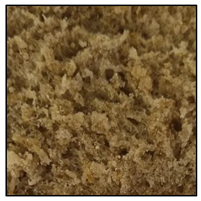 |  | 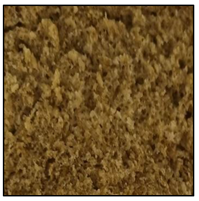 | |||||||||
| Control | Sc-5% | Sc-10% | |||||||||
 | 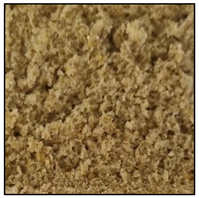 |  | 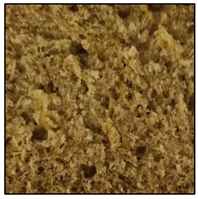 | ||||||||
| Sc-15% | FSc-5% | FSc-10% | FSc-15% | ||||||||
| Bread Parameters | Factors and Their Interaction | |||
|---|---|---|---|---|
| Scald Fermentation | Scald Quantity | Scald Fermentation and Quantity Interaction | ||
| Specific volume, cm3 g−1 | 0.188 | 0.139 | 0.785 | |
| Shape coefficient | 0.321 | 0.019 | 0.0001 | |
| Mass loss after baking, % | 0.205 | 0.259 | 0.025 | |
| Crust | L* | 0.153 | 0.111 | 0.037 |
| a* | 0.022 | 0.048 | 0.863 | |
| b* | 0.374 | 0.416 | 0.458 | |
| Crumb | L* | 0.154 | 0.016 | 0.080 |
| a* | 0.004 | 0.0001 | 0.0001 | |
| b* | 0.240 | 0.014 | 0.014 | |
| Bread Parameters | Factors and Their Interaction | ||
|---|---|---|---|
| Scald Fermentation | Scald Quantity | Scald Fermentation and Quantity Interaction | |
| Colour | 0.0001 | 0.953 | 0.189 |
| Odour intensity | 0.0001 | 0.003 | 0.0001 |
| Bread odour | 0.0001 | 0.322 | 0.012 |
| Additive odour | 0.0001 | 0.413 | 0.002 |
| Flavour intensity | 0.0001 | 0.424 | 0.0001 |
| Bread flavour | 0.0001 | 0.455 | 0.004 |
| Additive flavour | 0.0001 | 0.0001 | 0.0001 |
| Acidity | - | - | - |
| Bitterness | 0.0001 | 0.593 | 0.0001 |
| Porosity | 0.405 | 0.0001 | 0.508 |
| Brittleness | 0.0001 | 0.007 | 0.0001 |
| Springiness | 0.0001 | 0.685 | 0.0001 |
| Hardness | 0.0001 | 0.006 | 0.0001 |
| Moisture | 0.0001 | 0.003 | 0.0001 |
| Overall acceptability | 0.0001 | 0.395 | 0.0001 |
| Bread Parameters | Factors and Their Interaction | ||
|---|---|---|---|
| Scald Fermentation | Scald Quantity | Scald Fermentation and Quantity Interaction | |
| Acrylamide concentration | 0.172 | 0.0001 | 0.0001 |
Disclaimer/Publisher’s Note: The statements, opinions and data contained in all publications are solely those of the individual author(s) and contributor(s) and not of MDPI and/or the editor(s). MDPI and/or the editor(s) disclaim responsibility for any injury to people or property resulting from any ideas, methods, instructions or products referred to in the content. |
© 2023 by the authors. Licensee MDPI, Basel, Switzerland. This article is an open access article distributed under the terms and conditions of the Creative Commons Attribution (CC BY) license (https://creativecommons.org/licenses/by/4.0/).
Share and Cite
Klupsaite, D.; Starkute, V.; Zokaityte, E.; Cernauskas, D.; Mockus, E.; Kentra, E.; Sliazaite, R.; Abramaviciute, G.; Sakaite, P.; Komarova, V.; et al. The Contribution of Scalded and Scalded-Fermented Rye Wholemeal Flour to Quality Parameters and Acrylamide Formation in Semi-Wheat-Rye Bread. Foods 2023, 12, 937. https://doi.org/10.3390/foods12050937
Klupsaite D, Starkute V, Zokaityte E, Cernauskas D, Mockus E, Kentra E, Sliazaite R, Abramaviciute G, Sakaite P, Komarova V, et al. The Contribution of Scalded and Scalded-Fermented Rye Wholemeal Flour to Quality Parameters and Acrylamide Formation in Semi-Wheat-Rye Bread. Foods. 2023; 12(5):937. https://doi.org/10.3390/foods12050937
Chicago/Turabian StyleKlupsaite, Dovile, Vytaute Starkute, Egle Zokaityte, Darius Cernauskas, Ernestas Mockus, Evaldas Kentra, Rugilė Sliazaite, Gabriele Abramaviciute, Paulina Sakaite, Vitalija Komarova, and et al. 2023. "The Contribution of Scalded and Scalded-Fermented Rye Wholemeal Flour to Quality Parameters and Acrylamide Formation in Semi-Wheat-Rye Bread" Foods 12, no. 5: 937. https://doi.org/10.3390/foods12050937
APA StyleKlupsaite, D., Starkute, V., Zokaityte, E., Cernauskas, D., Mockus, E., Kentra, E., Sliazaite, R., Abramaviciute, G., Sakaite, P., Komarova, V., Tatarunaite, I., Radziune, S., Gliaubiciute, P., Zimkaite, M., Kunce, J., Avizienyte, S., Povilaityte, M., Sokolova, K., Rocha, J. M., ... Bartkiene, E. (2023). The Contribution of Scalded and Scalded-Fermented Rye Wholemeal Flour to Quality Parameters and Acrylamide Formation in Semi-Wheat-Rye Bread. Foods, 12(5), 937. https://doi.org/10.3390/foods12050937









